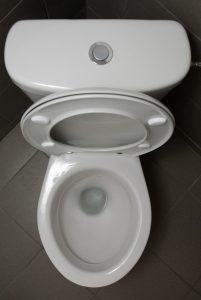The majority of homeowners are not aware that they can repair most minor toilet problems on their own. Whether it’s overflowing or running more than it should, toilets can be repaired often without calling a Willow Grove plumber; however, it is important to know the basic parts of a toilet before trying to troubleshoot toilet issues.
Here’s a guide to learning the parts of a toilet:

Tank: Pictured above (inspectapedia.com) is the tank on the back of the toilet, which holds the water supply for the bowl and the components that you need to know to fix most problems.
Bowl: Holds wastewater and uses the water from the tank to flush the waste.
Flush Handle: The flush handle is the part that everyone knows, but it’s important to know what happens when you flush: the flush handle is connected to the trip lever, which lifts the flapper and allows the water for the tank to enter the bowl.
Trip Lever: The trip lever is the part that you need to know for a running toilet. It attaches the flush handle to the flapper, and when you flush the toilet, this lever lifts the flapper (sometimes called a flapper valve) and releases the water from the tank into the bowl to force the wastewater in the bowl down the sewer drain. When a toilet is running, you can simply lift the trip lever to lower the water level in the tank.
Float Ball: The float ball basically measures the water in the tank. After you flush, the ball will fall as the water level lowers, and the ball will rise again as the tank fills from the toilet main water supply. When the tank has enough water, the toilet will stop running.
Overflow Tube: This is the tube that will stop the tank from overflowing if the toilet is running. It leads into the drain and pushes out all the excess water. Sometimes you can remove the rubber water supply tube from the overflow tube to keep a toilet from overflowing if you are not able to shut off the main water valve behind the toilet.
Flapper Valve: This is the part to know whenever you have an overflowing toilet or a backup. The flapper is attached to the flush handle by a chain and the trip lever. Whenever the flapper is pushed down, the water cannot leave the tank, so when you flush, it creates a suction to pressurize the water entering the bowl so that it has enough force to flush the waste. If your toilet is overflowing, push the flapper down with your hand so that it stops the water from entering the bowl. Most people are afraid to put their hands in the tank because they associate the tank water with the water in the bowl. The water in the toilet tank is clean because it comes from the main water supply line, which is attached to the stop valve.
Stop Valve: This is also called the toilet supply valve because it controls the fresh water supply going into the tank. It is usually located behind the toilet near the floor, and turning it off is another way to stop an overflowing toilet because the tank cannot fill once it is turned off. It is attached to the supply tube, which attaches to the refill tube.
Supply Tube: Although the supply tube and refill tube are connected, they are two different parts. People often use their names interchangeable, but what’s most important to know is that the supply tube supplies the water from the main line and into the refill tube, which refills the bowl.
Refill Tube: When the float ball is down, the refill tube fills the bowl with the water from the supply tube. After a flush, the ball rises, and when it reaches a certain level, the refill tube stops the flow of water into the bowl.
Trap: The trap is a seal that prevents backflow and strong odors from the main sewage line. If you smell sewage in your bathroom, particularly near the toilet, you could have a bad seal or faulty trap. Troubleshooting a trap usually requires a plumber, unless you are familiar with toilet installation.
Wax Ring: Another cause for bad odors is the wax ring, which is a seal between the toilet and the sewage line. A faulty wax ring could also cause leaking at the bottom of the toilet. Call a plumber whenever you aren’t sure about leaking toilets or strong sewer odors; there could be a problem in the main sewer line.
Call Carney Plumbing Heating & Cooling if you have any questions about these components, or if you want to trouble shoot with one of our Willow Grove plumbers.
Continue Reading
Tags: Bathroom Plumbing, King of Prussia, Lansdale, Plumbing, Plumbing Repair, Toliets, Willow Grove
Posted in Plumbing | Comments Off on Plumbing Basics: Learning the Parts of a Toilet
 Showers are like any other drain in your home: sometimes they get clogged and it’s up to you and a dedicated plumbing professional to take care of it.
Showers are like any other drain in your home: sometimes they get clogged and it’s up to you and a dedicated plumbing professional to take care of it.

 When you hear the word spa, what do you think of? Maybe a nice hotel, some pedicures, detoxing in a steam room while you relax. While that definitely sounds like a wonderful experience, what if we told you that there could be a spa in your own bathroom?
When you hear the word spa, what do you think of? Maybe a nice hotel, some pedicures, detoxing in a steam room while you relax. While that definitely sounds like a wonderful experience, what if we told you that there could be a spa in your own bathroom? You can look to a professional
You can look to a professional  This is one of the most common plumbing problems we get emergency calls about. We understand—it’s alarming to have a toilet suddenly start spilling water onto a bathroom floor with no signs of stopping!
This is one of the most common plumbing problems we get emergency calls about. We understand—it’s alarming to have a toilet suddenly start spilling water onto a bathroom floor with no signs of stopping!